Sturmey-Archer Dynohub
"Where's your lights sonny?"
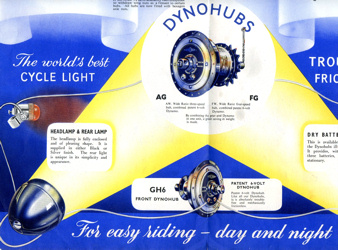 Many's the time a pale blue Ford Escort Mk1 would pull up in front of me with a blue light going around in a perspex dome on the roof. I usually didn't have lights because I didn't want to pay for batteries and an Ever-Ready back light would exhaust them within a week. Most of the time, the bulb would barely glow until a swift clout was directed at the casing. And the tin front light by Ever-Ready with it's cardboard battery was equally lacklustre. Then I came across a brown Bakelite Dynohub, aged about 13. At first I had no idea what it was, some kind of a brake? "Dyno" didn't register at all, as "Bakelite" will probably whizz over your head. Then I tried connecting some wires up to the small brass bolts and soon found that a 2.4 Volt bulb could be made to glow white hot, then pop.
Many's the time a pale blue Ford Escort Mk1 would pull up in front of me with a blue light going around in a perspex dome on the roof. I usually didn't have lights because I didn't want to pay for batteries and an Ever-Ready back light would exhaust them within a week. Most of the time, the bulb would barely glow until a swift clout was directed at the casing. And the tin front light by Ever-Ready with it's cardboard battery was equally lacklustre. Then I came across a brown Bakelite Dynohub, aged about 13. At first I had no idea what it was, some kind of a brake? "Dyno" didn't register at all, as "Bakelite" will probably whizz over your head. Then I tried connecting some wires up to the small brass bolts and soon found that a 2.4 Volt bulb could be made to glow white hot, then pop.
The classic GH6 Dynohub (Generator Hub, 6 Volt) was a dynamo contained in either the front or rear wheel hub. Originally they had been introduced during the war at 12 Volt, then 8 Volt before settling on 6 Volts. 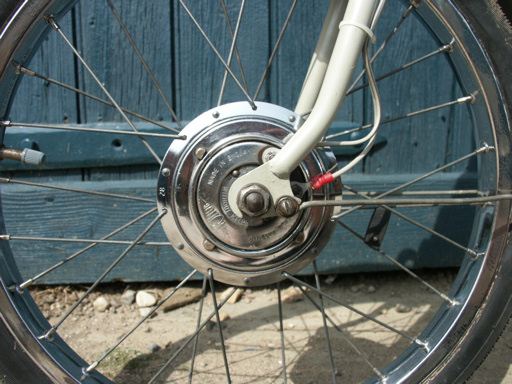 Sturmey-Archer made the Dynohub to the same design for almost forty years and the year of manufacture was stamped on the hub shell. The original power output was quoted as 2 Watts, but during the 1970's this was reduced to 1.8 Watts, possibly because of a change of magnet material. The early Dynohubs had a dark brown and rather delicate faceplate made from an early kind of thermosetting plastic, Bakelite. After that, they had a tin face with a satin silver finish that continued until the seventies. Lastly, the face was chromed like the one in the photo, the most handsome Dynohub of all. You are very likely to see a Dynohub on an old bike and if so, it is a good omen. The bicycle will generally be a good quality machine well worth restoring. Do not be put off by age. Sometimes the oldest Dynohubs are in the best condition inside their casings.
Sturmey-Archer made the Dynohub to the same design for almost forty years and the year of manufacture was stamped on the hub shell. The original power output was quoted as 2 Watts, but during the 1970's this was reduced to 1.8 Watts, possibly because of a change of magnet material. The early Dynohubs had a dark brown and rather delicate faceplate made from an early kind of thermosetting plastic, Bakelite. After that, they had a tin face with a satin silver finish that continued until the seventies. Lastly, the face was chromed like the one in the photo, the most handsome Dynohub of all. You are very likely to see a Dynohub on an old bike and if so, it is a good omen. The bicycle will generally be a good quality machine well worth restoring. Do not be put off by age. Sometimes the oldest Dynohubs are in the best condition inside their casings.
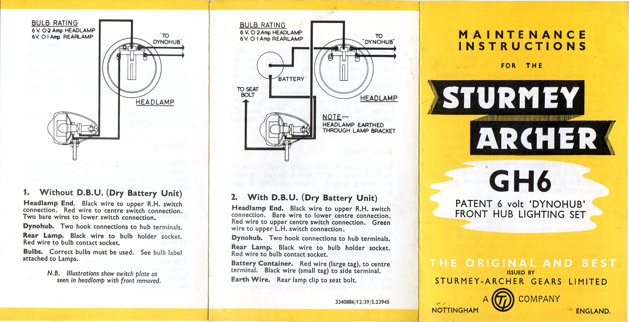 As a reckless youth, the thing to do was to connect a 3.5 Volt bulb on the front in series with a 2.5 Volt bulb at the rear. This combination worked brilliantly, allowing night-time racing around the smooth tarmacked paths of Crawford Park. However, bulbs expired frequently and met certain death at anything over 15 miles-per-hour. To be freed from the pocket-money sapping tyranny of Ever-Ready was worth the job of bulb replacement, and the fun derived from a burning searchlight scorching through the darkness plentiful reward. Years later I learned the correct values of bulb to be used with the GH6, and have never had quite so much enjoyment out of it since. The maintenance leaflet shown above is for a 1970's Dynohub and sets out the bulb values as 6V, 0.2A front and 6V, 0.1A rear. However, on earlier Dynohub systems you will usually find 6V, 0.04A in the rear. I have seen little tags in headlamps giving equal values for front and rear bulbs.
As a reckless youth, the thing to do was to connect a 3.5 Volt bulb on the front in series with a 2.5 Volt bulb at the rear. This combination worked brilliantly, allowing night-time racing around the smooth tarmacked paths of Crawford Park. However, bulbs expired frequently and met certain death at anything over 15 miles-per-hour. To be freed from the pocket-money sapping tyranny of Ever-Ready was worth the job of bulb replacement, and the fun derived from a burning searchlight scorching through the darkness plentiful reward. Years later I learned the correct values of bulb to be used with the GH6, and have never had quite so much enjoyment out of it since. The maintenance leaflet shown above is for a 1970's Dynohub and sets out the bulb values as 6V, 0.2A front and 6V, 0.1A rear. However, on earlier Dynohub systems you will usually find 6V, 0.04A in the rear. I have seen little tags in headlamps giving equal values for front and rear bulbs.
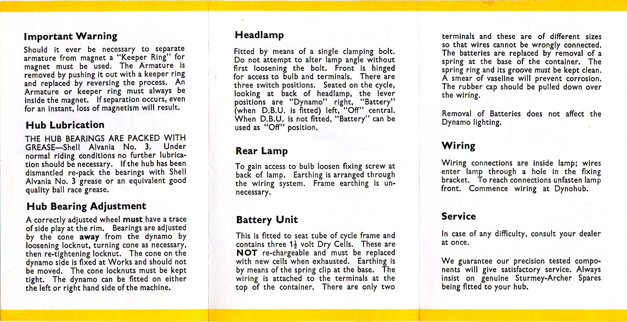 Modern cycle dynamos are more powerful than the Sturmey-Archer Dynohub, typically 3 Watts. This means that it is virtually impossible to get the right rating filament bulbs for Dynohubs from bike shops. However, with the advent of screw-in dynamo bulb replacements you can perform a valuable upgrade by changing the old filament bulbs to Nicelite LED bulbs. These are available from Reflectalite.com (website) and can also be bought from the same company on ebay here.
Modern cycle dynamos are more powerful than the Sturmey-Archer Dynohub, typically 3 Watts. This means that it is virtually impossible to get the right rating filament bulbs for Dynohubs from bike shops. However, with the advent of screw-in dynamo bulb replacements you can perform a valuable upgrade by changing the old filament bulbs to Nicelite LED bulbs. These are available from Reflectalite.com (website) and can also be bought from the same company on ebay here.
You don't want to be unlit when waiting at a traffic light, so it is a good idea to maintain an additional constant, reliable LED light on the rear. If you have upgraded to Nicelite bulbs, you can stay lit even with your Dynohub stopped for 45 seconds using the Standlight capacitor system. This is not available to buy but must be made by the cyclist; full approval given. See the circuit diagram by clicking on the photo below. Standlight also prevents strobing of Nicelite LED bulbs at slower speeds. A supplementary voltage regulator is recommended if you are not using the Standlight capacitor system. Raleigh bicycles of the 1950's were often fitted with a backup battery tube and these are still found occasionally. They maintain the lights when stationary and need to be switched on and off at the headlamp. Bit of a hassle.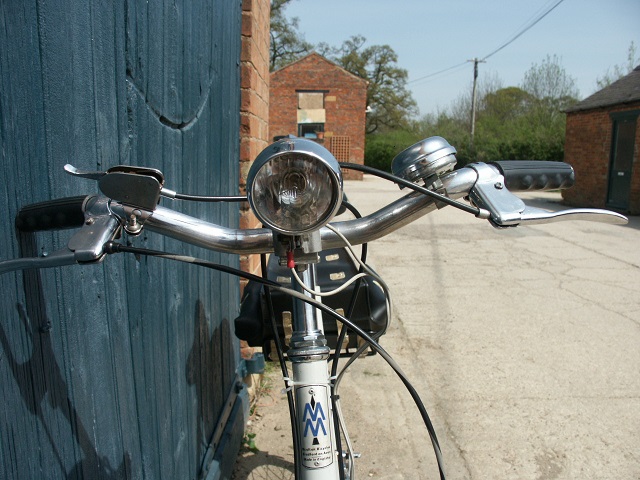 Moulton bicycles, with their 16" diameter wheels, are the perfect partners for Dynohubs because the wheels rotate much faster than a 26" wheel roadster, for example. That gives 62.5% more energy output for the Moulton at the same speed as the Triumph Palm Beach, and brighter lights. With modern LED bulbs that offer a searchlight level 120 lumens at the front and a red coloured foglight at the rear, now is the perfect time to polish up those beautiful chrome headlights and neat little Sturmey tail lights and reinstate them where they belong.
Moulton bicycles, with their 16" diameter wheels, are the perfect partners for Dynohubs because the wheels rotate much faster than a 26" wheel roadster, for example. That gives 62.5% more energy output for the Moulton at the same speed as the Triumph Palm Beach, and brighter lights. With modern LED bulbs that offer a searchlight level 120 lumens at the front and a red coloured foglight at the rear, now is the perfect time to polish up those beautiful chrome headlights and neat little Sturmey tail lights and reinstate them where they belong.


